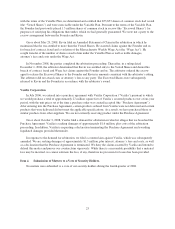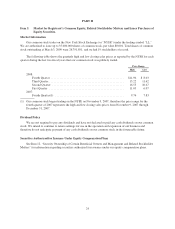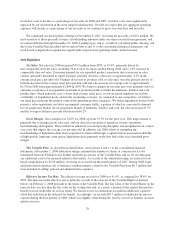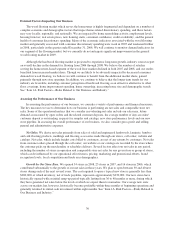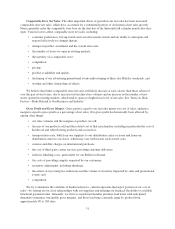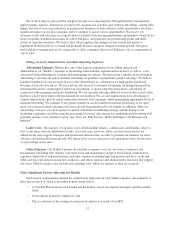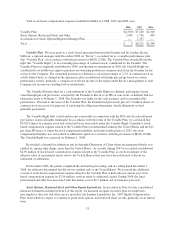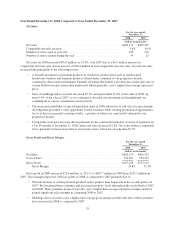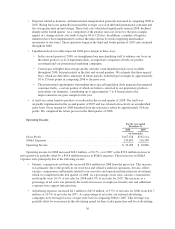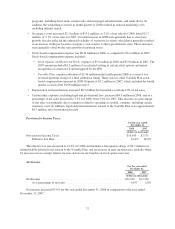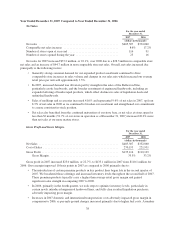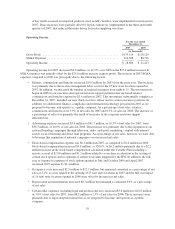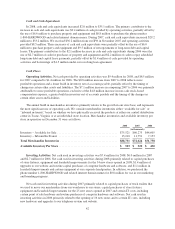Lumber Liquidators 2008 Annual Report Download - page 38
Download and view the complete annual report
Please find page 38 of the 2008 Lumber Liquidators annual report below. You can navigate through the pages in the report by either clicking on the pages listed below, or by using the keyword search tool below to find specific information within the annual report.We work to improve gross profits and gross margin on an ongoing basis through inventory management
improvements, logistics alternatives, pricing levels, promotional activities and vendor relationships, among other
things. Several of our recent initiatives to position our business for more effective future growth have also had a
significant impact on our gross margins, and we continue to assess various opportunities. We review our
inventory levels and sales mix on a regular basis to identify slow-moving merchandise and products which do not
meet our quality standards and cannot be sold at full price, and generally use promotional events and mark-
downs to clear that inventory. We believe that, taken together, the changes we have made and intend to
implement should enable us to sustain and gradually increase our gross margins in future periods. Our gross
profit and gross margin may not be comparable to other companies that record different costs as components of
cost of sales.
Selling, General, Administrative and Other Operating Expenses.
Advertising Expenses. Historically, one of the largest components of our selling, general and
administrative (or “SG&A”) expenses is advertising at the national, regional and local level, as well as, costs
associated with publishing our catalogs and maintaining our website. We have made a significant investment in
advertising to develop our national brands, including our portfolio of proprietary product offerings. We believe
Lumber Liquidators is now recognized across the United States as a destination for high-quality hardwood
flooring at everyday low prices. We have historically focused on national advertising, including buying ads in
national publications, using targeted television advertising, co-sponsoring television shows, advertising on
syndicated radio programs and sports marketing. We are currently placing additional focus on direct mail efforts
that have a more direct link to driving demand for our products. We are also emphasizing local advertising to
support targeted store growth and in connection with new store openings, while maintaining appropriate levels of
national advertising. We continue to see greater returns on our investment in national advertising as we open
more stores near potential customers who have already been introduced to our brands. In addition, while our
advertising costs may vary from quarter to quarter with shifts in marketing strategy and the timing of our
marketing campaigns, we believe that the percentage of our net sales devoted to marketing and advertising will
generally decline as we continue to grow. See “Item 1A. Risk Factors—Risks Relating to Our Business and
Industry.”
Labor Costs. The majority of our labor costs, which include salaries, commissions and benefits, relate to
staff at our stores and our distribution facility. In recent years, however, labor costs have increased as we
enhanced our store support strategies and operational infrastructure, in order to position our business for more
effective and sustainable future growth. We expect labor costs to increase as we open more stores, but decrease
as a percentage of net sales.
Other Expenses. Our SG&A expenses also include occupancy costs for our stores, warehouse and
headquarters (including rent, utilities, real estate taxes and maintenance charges); stock-based compensation
expenses; depreciation and amortization; and other expenses including legal and professional fees, credit and
debit card discount and processing fees, bank fees, and other corporate and administrative functions that support
our stores. SG&A expenses also include store opening costs, which we expense as they are incurred.
Other Significant Factors Affecting our Results
Stock-based compensation expense has significantly impacted our total SG&A expenses, due primarily to
three factors (each of which is described in more detail below):
• A Variable Plan between our Founder and his brother, one of our regional managers until December
2008;
• Stock options granted to employees; and
• The acceleration of the vesting of certain stock options as a result of our IPO.
32



